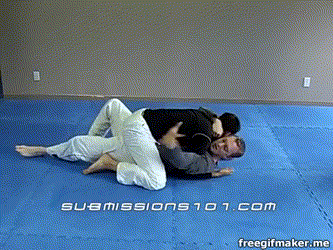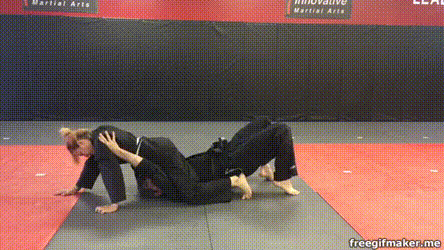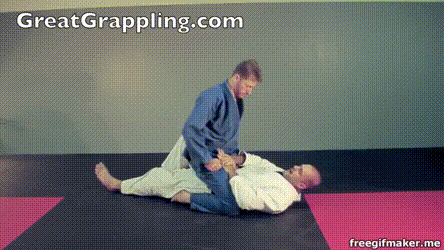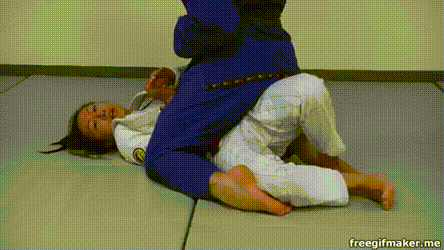
Getting stuck at the bottom of the mount is one aspect of BJJ nobody enjoys. There’s hardly a more uncomfortable position than the mount. Luckily, there is a way out of this position. Actually, there is more than one way out. However, the thing you need to understand about mount escapes is the selection. You need to know which escape using in which situation. If you go for the wrong one…well, you already know what happens. However, if you get it right you have options and lots of them!
Discovering a way out of mount is a trap for most beginners in Brazilian Jiu-Jitsu. The thing with the mount is that you’re both bearing the weight of your opponent and are at risk of submissions at the same time. NO other position offers the same amount of combined threat and discomfort as the mount. Such is the power of the position that even when you discover a basic escape, you’re still at risk. You see, doing just one escape against the mount is a trap that’s going to get you stuck even worse. To escape this spiderweb of traps, you need to have a variety of mount escapes at your disposal.
The correct approach to developing an arsenal of effective mount escapes is not via the accumulation of different techniques. The more techniques you look for, the more confused you’re going to get. Instead, you need to simplify the process. Since one escape rarely works, you need to have fallbacks. In order to e effective with escaping, you have to understand the mount position. And finally, you need to base your escapes around the concepts of the mount rather than individual techniques. This is a proven way of successfully getting out of the mount.
Make sure you never struggle to escape any position in Jiu-Jitsu ever again! Tom DeBlass is a BJJ black belt who is unsubmittable thanks to the fact he doesn’t spend any time in inferior positions. His secret is in lighting fast and simple scapes. Now, he shares his defensive knowledge with you in his “Submission Escapes” DVD set”. Get it and never fear an attack again!
The Mount Position
The mount position revolves around fairly simple mechanics. That doesn’t make it any less uncomfortable and difficult to escape. With the mount, you have a person riding on top of you, while you’re on your back. From there an opponent that knows how to hold mount can move in one of two main directions to make your life hell.
The first version of the mount is a low mount. This is what most people associate with the mount position as beginners. In a low mount, the opponent’s hips are right over yours, and their torso is lying on top of yours. Their arms are usually involved in controlling your arms and head or setting up attacks. Their feet can be grapevine in between your legs or kept tight against the sides of your hips. The opponent’s hips often drive down into yours, making it virtually impossible to get out. Unless you know the right mount escapes, of course.
The second most common version of a mount is the high mount. This position can make an opponent unbearably heavy. even worse, it opens up plenty of submission options for them. At the same time, it is notoriously difficult for you to defend yourself. In the high mount, an opponent is literally sitting on your sternum, their legs on either side of your chest. From this position, your arms are most likely trapped out wide due to their knees digging into your armpits. An experienced opponent is really difficult to budge from the high mount.
The S-mount is a whole different can of worms, so we’re just going to mention it here. A complete article on how to escape it safely is planned for the future.
Basic Principals Of Mount Escapes
So, what do mount escapes have to focus on in order to get you out quickly and easily? Well, it depends on the type of mount your opponent has. Escapes that work against the low mount are not effective against eh high mount, and vice versa. that said, if you understand the principles behind both mount variations, you’ll know how to escape the theme as well.
First and foremost you need to understand the concept of direction. In terms of mount escapes, you can either move your opponent over you, or you can move under the opponent. These main directions work for both mount variations but are applicable in different situations.
One more thing you need to be certain off when in the mount is safety. There’s no point of looking for mount escapes if there’s a choke or an armlock incoming. SO keeping your neck and arms safe is your primary concern. keeping your arms as tight as possible to your torso, palms on the neck/collar is the best way to stay safe. Once everything is tucked in place, you can look to employ mount escapes.
-
The “Upa” Escape

First and foremost, stay safe as we already discussed. next, You need to choose the side you’re going to tilt the opponent to. As a rule of thumb, if they have an arm under your head, that’s the side you go to. First, you’ll use an arm to trap their arm, so that they can’t post when you go for the escape. Next, you’re going to use one of your feet, to trap the same side leg from the outside. This serves the same purpose as trapping the arm. Only when you have one side completely isolated, you can think about bridging as high as possible and then turning onto your shoulder. The goal here is to end up in the full guard.
-
The Armpit Escape
This is an escape that is really attractive and does require certain flexibility. Worry not, though, as even completely inflexible grapplers can add it to their mount escapes with ease. All it takes are some angle adjustments.

-
The Sliding Hip Escape
The previous two escapes were all about moving your opponent in order to go for mount escapes. This escape is one in which you’re going to focus on moving yourself under the opponent. It is an escape that works from both the high and low mount. It opens up certain risks of attacks, so you need to be quick with it.

-
The “Marcelo Garcia” Escape
This one is a real gem among mount escapes. It is a very tricky, very easy escape to do. In essence, you just build a frame with your legs and lay on the ground. Your opponent is going to end up in your half guard no matter what. This one is perfect to use against larger opponents. It is a low mount escape so avoid using it in the high mount, when you don’t have access to the opponent’s legs.

Related Articles:
Simple Side Control Escape Concepts You Must Know
Three Easy Ways To Improve Your BJJ Posture
Side Control Escape – The Biggest Mistake That Everyone Does


![Darce Choke Encyclopedia – Origins, Mechanics and Variations [2025] BJJ, choke, Brabo, BJJ Darce Choke, D'arce Choke, Darce BJJ Choke](https://bjj-world.com/wp-content/uploads/2017/11/JungPoirierLeeYahoo-218x150.jpg)









![Get Off My Legs Gringo Craig Jones DVD Review [2025] Get Off My Legs Gringo Craig Jones DVD Review](https://bjj-world.com/wp-content/uploads/2025/03/get-off-my-legs-gringo-craig-jones-dvd-review-218x150.png)

![Leg Lock Entries Helena Crevar DVD Review [2025] Leg Lock Entries Helena Crevar DVD Review](https://bjj-world.com/wp-content/uploads/2025/03/leg-lock-entries-helena-crevar-dvd-review-218x150.png)
![Special K Guard Neil Melanson DVD Review [2025] Special K Guard Neil Melanson DVD Review](https://bjj-world.com/wp-content/uploads/2025/03/special-k-guard-neil-melanson-dvd-review-218x150.png)
![Arm Bar It All Shawn Melanson DVD Review [2025] Arm Bar It All Shawn Melanson DVD Review](https://bjj-world.com/wp-content/uploads/2025/03/arm-bar-it-all-shawn-melanson-dvd-review-218x150.png)



![Mastering Takedown Prevention Steve Mocco DVD Review [2024] Mastering Takedown Prevention Steve Mocco DVD Review](https://bjj-world.com/wp-content/uploads/2024/11/mastering-takedown-prevention-steve-mocco-dvd-review-100x70.png)
![Grappling Takedown Dominance Brandon Ruiz DVD Review [2025] Grappling Takedown Dominance Brandon Ruiz DVD Review](https://bjj-world.com/wp-content/uploads/2025/01/grappling-takedown-dominance-brandon-ruiz-dvd-review-100x70.png)
![Roger Gracie Closed Guard System DVD Review [2025] Roger Gracie Closed Guard System DVD Review](https://bjj-world.com/wp-content/uploads/2025/01/roger-gracie-closed-guard-system-dvd-review-100x70.png)

![Advanced Chin Control Concepts David Petrone DVD Review [2025] Advanced Chin Control Concepts David Petrone DVD Review](https://bjj-world.com/wp-content/uploads/2025/01/chin-control-concepts-david-petrone-dvd-review-100x70.png)
![Slay The Wrestle Up Guard Nick Rodriguez DVD Review [2024] Slay The Wrestle Up Guard Nick Rodriguez DVD Review](https://bjj-world.com/wp-content/uploads/2024/12/slay-the-wrestle-up-guard-nick-rodriguez-dvd-review-100x70.png)
![Finish on the Back Ethan Crelinsten DVD Review [2024] Finish on the Back Ethan Crelinsten DVD Review](https://bjj-world.com/wp-content/uploads/2024/10/finish-on-the-back-ethan-crelinsten-dvd-review-100x70.png)

![Roger Gracie Guard Passing System DVD Review [2025] Roger Gracie Guard Passing System DVD Review](https://bjj-world.com/wp-content/uploads/2025/02/roger-gracie-guard-passing-system-dvd-review-100x70.png)
![Dubious De La Riva Dominique Bell DVD Review [2024] Dubious De La Riva Dominique Bell DVD Review](https://bjj-world.com/wp-content/uploads/2024/10/dubious-de-la-riva-dominique-bell-dvd-review-100x70.png)


![BJJ Foundations Mikey Musumeci DVD Bundle Review [2024] BJJ Foundations Mikey Musumeci DVD Bundle Review](https://bjj-world.com/wp-content/uploads/2024/09/bjj-foundations-mikey-musumeci-dvd-bundle-review-100x70.png)
![Edging Yourself Out Of Danger Craig Jones DVD Review [2024] Edging Yourself Out Of Danger Craig Jones DVD Review](https://bjj-world.com/wp-content/uploads/2024/12/edging-yourself-out-of-danger-craig-jones-dvd-review-100x70.png)
![Back Hacks Yigit Haney BJJ DVD Review [2025] Back Hacks Yigit Haney BJJ DVD Review](https://bjj-world.com/wp-content/uploads/2024/12/back-hacks-yigit-haney-bjj-dvd-review-100x70.png)
![Henry Akins Black Hole No-Gi Closed Guard DVD Review [2024] Henry Akins Black Hole No-Gi Closed Guard DVD Review](https://bjj-world.com/wp-content/uploads/2024/09/henry-akins-black-hole-no-gi-closed-guard-dvd-review-100x70.png)
![Tiny Woman Guide To The Guard Ann Kneib DVD Review [2024] Tiny Woman Guide To The Guard Ann Kneib DVD Review](https://bjj-world.com/wp-content/uploads/2024/11/tiny-woman-guide-to-the-guard-ann-kneib-dvd-review-100x70.png)






![The Closed Guard Malachy Friedman BJJ DVD Review [2025] The Closed Guard Malachy Friedman BJJ DVD Review](https://bjj-world.com/wp-content/uploads/2025/01/closed-guard-malachy-friedman-bjj-dvd-review-100x70.png)
![Knee Lever John Wayne Sweep Adam Wardzinski DVD Review [2024] Knee Lever John Wayne Sweep Adam Wardzinski DVD Review](https://bjj-world.com/wp-content/uploads/2024/12/john-wayne-sweep-adam-wardzinski-dvd-review-100x70.png)
![Reverse De La Riva System Mikey Musumeci DVD Review [2024] Reverse De La Riva System Mikey Musumeci DVD Review](https://bjj-world.com/wp-content/uploads/2024/11/reverse-de-la-riva-system-mikey-musumeci-dvd-review-100x70.png)

